
2nd Issue 2007
(I) Amendments to the Food and Drugs (Composition and Labelling) Regulations
To protect consumer interests and facilitate them to make suitable choices on prepackaged food, the Food and Drugs (Composition and Labelling) (Amendment) Regulation 2004 was enacted on 9 July 2004 to serve as the labelling guidelines. A 36-month grace period ending 9 July 2007 was granted to allow the trade sufficient time to adapt to the new regulations.
The Amendment Regulation requires the declaration of eight types of substances which are known to cause allergy to some individuals on the food label. These substances include cereals containing gluten (namely wheat, rye, barley, oats, spelt, their hybridized strains and their products), crustacean and crustacean products, egg and egg products, fish and fish products, peanuts, soybeans and their products; milk and milk products (including lactose); tree nuts and nut products and sulphite in concentrations of 10 parts per million or more.
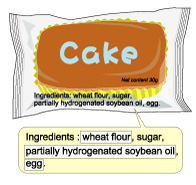
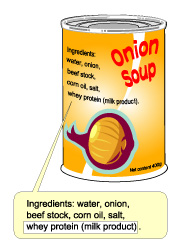
The Amendment Regulation also requires the listing of the specific name (or identification number under the International Numbering System for Food Additives adopted by the Codex Alimentarius Commission) and functional class of any additives used on the food label.
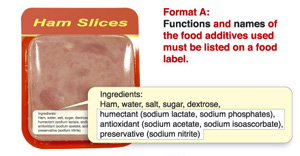
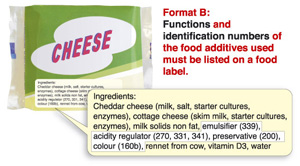
To facilitate consumers to understand the labels of "best before" or "use by", the expiry date shall be shown in the order of day, month and year, and in both English and Chinese.

Apart from the above amendments, food manufacturers are required to comply with the following conditions in preparing food labels:
|
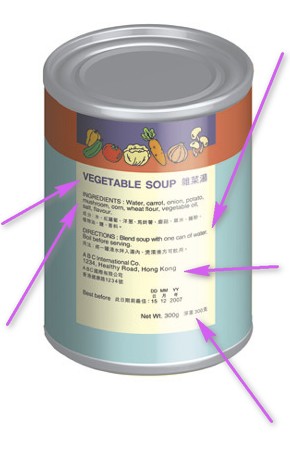 |
|
Detailed information on the labelling guidelines can be found at the web page of the Centre for Food Safety at http://www.cfs.gov.hk/english/food_leg/food_leg_lgfa.html

(II) What are Escolar and Oilfish?
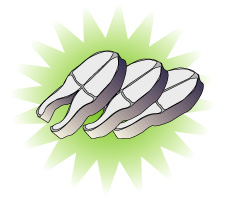
Escolar (Lepidocybium flavobrunneum) and oilfish (Ruvettus pretiosus) are rich in fat. According to the food nutrient data from USDA, 100g of oilfish contain 20g fat, including a naturally present wax ester.
In humans, wax esters are indigestible and will accumulate in the rectum causing oily diarrhea and significant discomfort. However, not all people are affected by the wax ester. The affected will have symptoms such as stomach cramps and rapid loose bowel movements, with onset time ranging from 30 minutes to 36 hours after consumption. Recovery is expected within 24 to 48 hours.
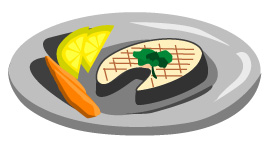
Advice to the Public
- When choosing escolar and oilfish, consumers should be aware of the possible health effects associated with eating such fish and their related species. They should consume in small portion for the first time to determine their susceptibility.
- Maintain a balanced diet with a variety of food.
- Seek medical advice if gastrointestinal symptoms develop.
- In case of doubt about the type of fish, seek more information and clarification from the seller before purchase.

(III) Listeria Monocytogenes
Listeria monocytogenes are commonly found in nature (e.g. soil, water) and in some foods. Though the bacteria can survive and multiply in an environment with a temperature as low as -4℃, they can be killed at normal cooking temperature.
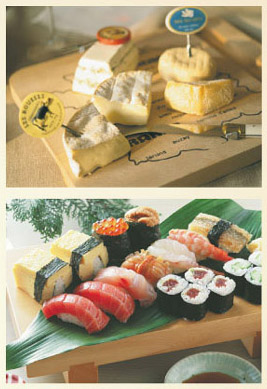
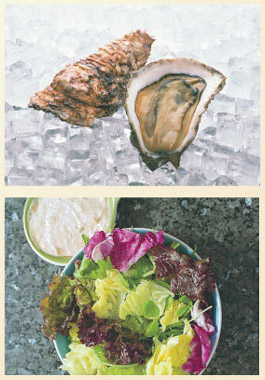
Symptoms
Different people may have different symptoms, depending on their level of immunity. Common symptoms are similar to those of influenza such as fever, headache, vomiting and diarrhea. The effect on pregnant women, newborns, the elderly and people with compromised immunity, however, can be severe. Infected pregnant women may transmit the bacteria to their foetus, leading to miscarriage, still birth, premature birth or serious illnesses in a newborn baby.
Prevention
Pregnant women, the elderly and people with compromised immunity should avoid consuming high risk chilled or frozen ready-to-eat foods, including soft cheeses, pates, prepared and stored salads, raw seafoods (such as sashimi and oysters) and unpasteurised milk, etc.
Food and Personal Hygiene
Raw foods and leftover should be thoroughly cooked and reheated before consumption. Wash hands thoroughly after using toilet as well as before and after food preparations.

The Web Page of the Centre for Food Safety
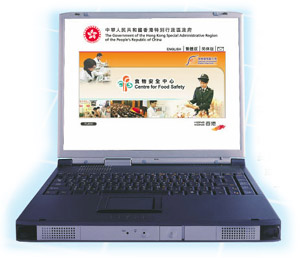
Welcome to the web page of the Centre for Food Safety (CFS) at http//www.cfs.gov.hk. After choosing the language preferred, you will enter into a new and specially-designed CFS' web page where you will find a wide range of useful information. Columns include Latest News, Food Alert and Food Safety Tips. You can also learn about the activities launched by CFS with brief description.
A full array of information is available when you click on the "Frequently Asked Questions". For suggestions, complaints or enquiries, please click on "Contact Us".
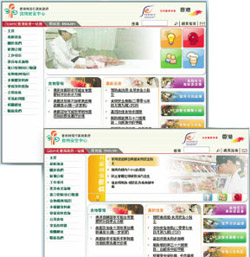
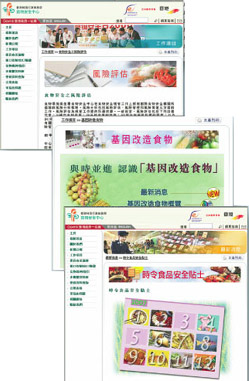
Prevention of Norovirus Infection
Norovirus, a virus smaller than bacteria, is a major cause of non-bacterial food poisoning resulting in infectious gastro-intestinal diseases. Symptoms include nausea, vomiting, diarrhoea and abdominal cramps etc.
Mode of Transmission
- intake of food or water contaminated with the virus
- contact with vomitus or faeces from infected persons
- contact with contaminated objects
- person-to-person aerosol or droplet spread
High Risk Food
Norovirus mainly exists in dirty water. Shellfish living in polluted waters or vegetables irrigated with water from polluted origins are easily contaminated. Consumption of these food, including shellfish, salads and vegetables, raw or uncooked, is prone to norovirus infection.
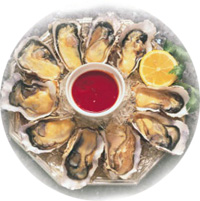

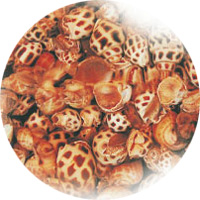
Prevention
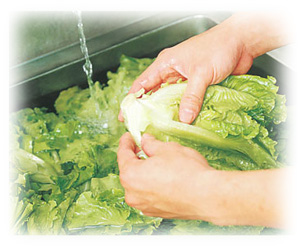
- Shop at licensed and reliable outlets.
- All foods, in particular shellfish and oyster, should be thoroughly cooked.
- Vegetables to be eaten raw or for making salad should be thoroughly washed, properly wrapped and stored in the refrigerator at 4℃ or below.
- Wash hands thoroughly with soap and water after using toilet, before handling food or before eating.
Food Safety Plan Corner
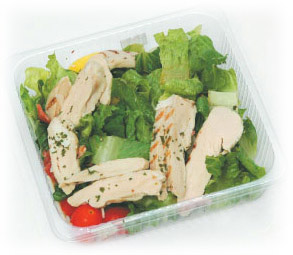
Hazard Analysis and Critical Control Point (HACCP) ── Salads
Critical Control Points of Salads Production (for Food Trade)
Salads are mixtures of ready-to-eat vegetables and fruits. Other common ingredients are poultry, meat, seafoods, eggs and nuts. Salads are to be served cold. As the ingredients are not cooked and the preparation requires a lot of handling, food safety risk will be largely increased if the salads are not handled properly.
To ensure safe consumption of salads, the trade should control the critical points in production. Take for example the making of shredded chicken salad:
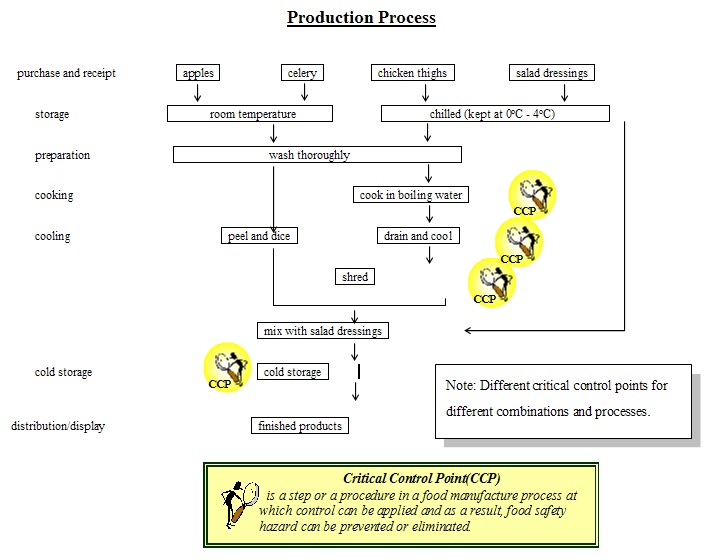
Guildlines on Salads Production
- Good production measures
- Maintain good personal hygiene practices. Wash hands with liquid soap for at least 20 seconds before handling food or after using toilet.
- Keep all equipment and utensils clean and properly maintained.
- Measure the core temperature of food with a clean and accurate thermometer.
- Purchase and receipt
 Check that the raw ingredients have no signs of contamination or damage and they have not passed the "expiry" or "best before" date.
Check that the raw ingredients have no signs of contamination or damage and they have not passed the "expiry" or "best before" date. Upon delivery of raw ingredients, check to ensure that chilled foods (e.g. meat) are stored at or below 4℃ and frozen items in frozen state without signs of defrosting.
Upon delivery of raw ingredients, check to ensure that chilled foods (e.g. meat) are stored at or below 4℃ and frozen items in frozen state without signs of defrosting.
- Storage
- Store the ingredients immediately and at proper temperature: chilled items at 4℃ or below and frozen items at -18℃ or below.
- Practice first-in-first-out stock rotation method.
- Keep raw ingredients covered/wrapped until use.
- Store ready-to-eat and raw foods separately.
- Preparation / Cooking / Cooling

 Ingredients (e.g. meat) that need cooking have to be cooked thoroughly until the core temperature reaches 75°C or above for 30 seconds.
Ingredients (e.g. meat) that need cooking have to be cooked thoroughly until the core temperature reaches 75°C or above for 30 seconds. Cool food as soon as possible: cool food from 60°C to 20°C in 2 hours and to 4°C in the next 4 hours.
Cool food as soon as possible: cool food from 60°C to 20°C in 2 hours and to 4°C in the next 4 hours.- When washing vegetables and fruits, pay attention to the followings:
- wash ready-to-eat fruits and vegetables in a sink exclusively for this purpose as far as practicable.
- choose appropriate disinfectants and follow manufacturers' instructions if disinfectants are used.
- Store salad dressings in the refrigerator at 4°C or below once their packages are opened.
- Avoid holding chilled ingredients or finished products at 4°C or above for more than 2 hours.
- Label the "use-by" date on pre-packaged salad with other information such as conditions for storage.
- Use separate equipment and utensils to handle ready-to-eat and raw foods to avoid cross-contamination.
- Distribution/Display
 Chilled products should be stored at 4°C or below in the refrigerator to protect them from contamination and deterioration.
Chilled products should be stored at 4°C or below in the refrigerator to protect them from contamination and deterioration.- Distribute and sell finished products according to the first-in-first-out principle.
- Self-serve salad bar
- Display salad ingredients in a proper manner and at 4°C or below to protect them from contamination and deterioration.
- Provide sufficient number of tongs or ladles with long handles and replace them with clean ones when appropriate. Remove the dirty ones (e.g. those dropped on the floor) from the salad bar area immediately.
- Display ingredients in small portions and avoid topping up with fresh ones.
- Discard leftovers.
- Assign appropriately trained staff to supervise the salad bar area to protect the foods from contamination by customers.
- Management System
Implement a preventive food safety management system (e.g. Hazard Analysis and Critical Control Point System) to identify and control food safety problems at every stage of the food production process.
Activities*
Trade Consultation Forum

The Centre for Food Safety (CFS) held the fourth Trade Consultation Forum on 16 March 2007 with the participation of various food trade associations, food manufacturers, food importers and wholesalers, supermarket operators and retailers. Topics discussed include amendments to Preservatives in Food Regulations, enforcement of the Food and Drugs (Composition and Labelling) Regulations and how to strengthen the legislations to safeguard food safety. Representatives from the CFS also reported on the latest risk communication activities.


For details of the discussion at the forum, please visit the following web page: http://www.cfs.gov.hk/english/
committee/committee_tcf.html.